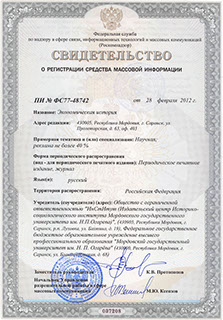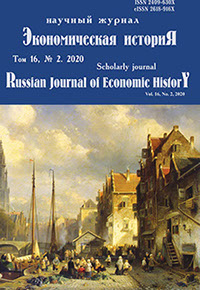Экономическая историЯ
Russian Journal of Economic History
ISSN 2409-630X (Print)
ISSN 2618-916X (Online)
Expert board:
- Scientific Council of RAS on economic history;
- Research and Educational Center «The economic history of Central Russia and the Middle Volga region» of Ogarev Mordovia State University;
- Center of Economic History of Lomonosov Moscow State University
Navigation
Certificate of registration

ISSN 2409-630X (Print), ISSN 2618-916X (Online)
DOI: 10.15507/2409-630X.049.016.202002.167-179
Marina A. Klinova
Ural state University of Economics (Yekaterinburg, Russia),
e-mail: klinowa.m@yandex.ru
Problems of Urban Welfare Population on the Pages of the National Periodical Press of 1946–1956
Introduction. The post-war period of Russian history was associated with difficulties and problems of survival of citizens. The current direction of the research is the problems of living standards and prospects for improving the well-being of citizens, presented on the pages of print media of the post-war decade. Materials and Methods. The methodological basis of the research is the modernizing historical paradigm, which is a macro-level methodology focused on the study of social changes, transformations and innovative measures that are recorded in the process of development of society. The research was based on the materials of fifteen periodicals of various levels (magazines, central, regional, city, and factory newspapers). Work with historical sources was carried out using general scientific methods (analysis, synthesis, induction, etc.), as well as historical methods (problem-chronological, retrospective, comparative-historical). To achieve the goals of the study, we used a qualitative and quantitative method (content analysis), which allows us to identify the quantitative expression of the media’s appeal to the problems of the population’s welfare. Results and Discussion. The analysis of the materials of periodicals of 1946–1956 allowed us to identify two models of media rhetoric (successive ones), in which the problems of welfare were considered. In the framework of the “future welfare” model, presented in the media in the second half of the 1940s, the appeal to the concept of “welfare” was not characterized by a high level of demand, and publications that covered various aspects of the deficit were quantitatively expressed. The task of improving the material well-being of citizens was postponed until the state’s economy was restored. In the 1950s, a new model of “realized well – being” was approved in the domestic information field. It was aimed at presenting the consumer practices of citizens in a positive light and increasing the level of personal consumption. Meeting the growing material needs of citizens is interpreted as the most important task of the state, the solution of which was a priority regardless of the potential economic opportunities of the country. Conclusion. The specifics of considering the problems of population welfare were determined by the dynamics of the country’s economic development, the vector of the social policy, and the intensity of the articulated mobilization tasks.
Keywords: welfare, urban population, needs, periodicals, content analysis.
For citation: Klinova M. A. Problems of urban welfare population on the pages of the national periodical press of 1946–1956. Ekonomicheskaya istoriya = Russian Journal of Economic History. 2020; 16(2): 167–179. (In Russ.). DOI: 10.15507/2409-630X.049.016.202002.167-179
© Ogarev Mordovia State University. History and Sociology Institute, 2017
68, Of. 411, Bolshevistskaya St., 430005, The editorial office of the scholarly journal «Russian Journal of Economic History»
Tel.: (8342) 24-25-90; 27-07-11, Fax: (8342) 24-25-90, E-mail: jurnal-econom-hist@isi.mrsu.ru
Designed by A. Napalkov, Email: napalkov@isi.mrsu.ru

